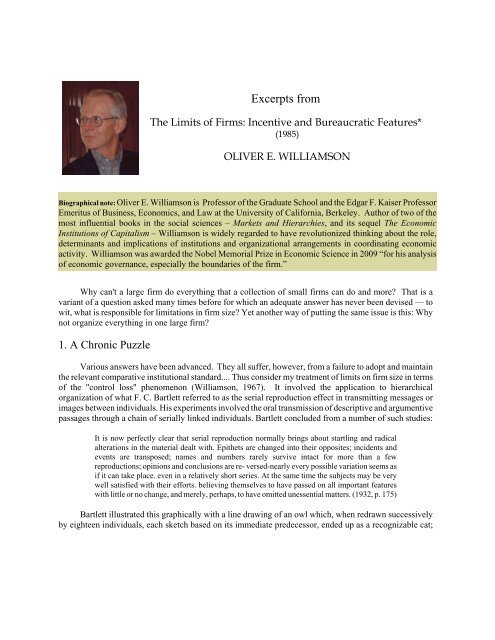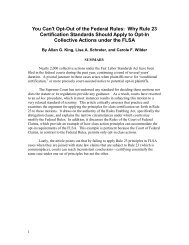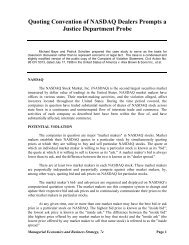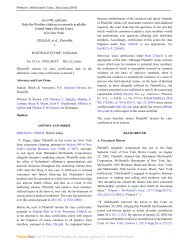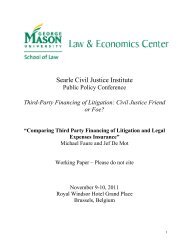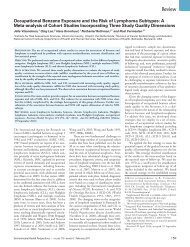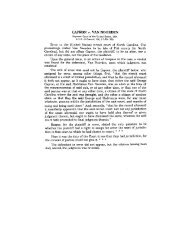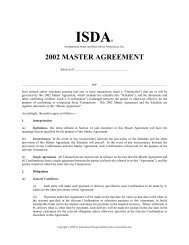The Limits of Firms: Incentive and Bureaucratic Features - Law ...
The Limits of Firms: Incentive and Bureaucratic Features - Law ...
The Limits of Firms: Incentive and Bureaucratic Features - Law ...
You also want an ePaper? Increase the reach of your titles
YUMPU automatically turns print PDFs into web optimized ePapers that Google loves.
Excerpts from<strong>The</strong> <strong>Limits</strong> <strong>of</strong> <strong>Firms</strong>: <strong>Incentive</strong> <strong>and</strong> <strong>Bureaucratic</strong> <strong>Features</strong>*(1985)OLIVER E. WILLIAMSONBiographical note: Oliver E. Williamson is Pr<strong>of</strong>essor <strong>of</strong> the Graduate School <strong>and</strong> the Edgar F. Kaiser Pr<strong>of</strong>essorEmeritus <strong>of</strong> Business, Economics, <strong>and</strong> <strong>Law</strong> at the University <strong>of</strong> California, Berkeley. Author <strong>of</strong> two <strong>of</strong> themost influential books in the social sciences – Markets <strong>and</strong> Hierarchies, <strong>and</strong> its sequel <strong>The</strong> EconomicInstitutions <strong>of</strong> Capitalism – Williamson is widely regarded to have revolutionized thinking about the role,determinants <strong>and</strong> implications <strong>of</strong> institutions <strong>and</strong> organizational arrangements in coordinating economicactivity. Williamson was awarded the Nobel Memorial Prize in Economic Science in 2009 “for his analysis<strong>of</strong> economic governance, especially the boundaries <strong>of</strong> the firm.”Why can't a large firm do everything that a collection <strong>of</strong> small firms can do <strong>and</strong> more? That is avariant <strong>of</strong> a question asked many times before for which an adequate answer has never been devised — towit, what is responsible for limitations in firm size? Yet another way <strong>of</strong> putting the same issue is this: Whynot organize everything in one large firm?1. A Chronic PuzzleVarious answers have been advanced. <strong>The</strong>y all suffer, however, from a failure to adopt <strong>and</strong> maintainthe relevant comparative institutional st<strong>and</strong>ard.... Thus consider my treatment <strong>of</strong> limits on firm size in terms<strong>of</strong> the "control loss" phenomenon (Williamson, 1967). It involved the application to hierarchicalorganization <strong>of</strong> what F. C. Bartlett referred to as the serial reproduction effect in transmitting messages orimages between individuals. His experiments involved the oral transmission <strong>of</strong> descriptive <strong>and</strong> argumentivepassages through a chain <strong>of</strong> serially linked individuals. Bartlett concluded from a number <strong>of</strong> such studies:It is now perfectly clear that serial reproduction normally brings about startling <strong>and</strong> radicalalterations in the material dealt with. Epithets are changed into their opposites; incidents <strong>and</strong>events are transposed; names <strong>and</strong> numbers rarely survive intact for more than a fewreproductions; opinions <strong>and</strong> conclusions are re- versed-nearly every possible variation seems asif it can take place. even in a relatively short series. At the same time the subjects may be verywell satisfied with their efforts. believing themselves to have passed on all important featureswith little or no change, <strong>and</strong> merely, perhaps, to have omitted unessential matters. (1932, p. 175)Bartlett illustrated this graphically with a line drawing <strong>of</strong> an owl which, when redrawn successivelyby eighteen individuals, each sketch based on its immediate predecessor, ended up as a recognizable cat;
to adapt will be cause for termination. Upon realization that successor managements can always be broughtin to implement change orders as requested, the incumbent management always acquiesces.Were this the end <strong>of</strong> the story, selective intervention with net gains would presumably obtain. In fact,however, numerous measurement difficulties st<strong>and</strong> in the way <strong>of</strong> implementing a merger agreement that isattended by high powered incentives. Some <strong>of</strong> them operate to the disadvantage <strong>of</strong> the buyer, some workto the disadvantage <strong>of</strong> the supplier, <strong>and</strong> others impose losses on both.2.1 Asset Utilization Losses<strong>The</strong> former owner-manager <strong>of</strong> the supply stage becomes the manager <strong>of</strong> the supply division upon sale<strong>of</strong> the supply stage assets to the buyer. <strong>The</strong> change <strong>of</strong> status has immediate <strong>and</strong> serious incentive effects ifthe high-powered incentive rules described above are employed. For one thing, the manager whoappropriates the net receipts associated with the supply division no longer has the same incentives to utilizeequipment with equivalent care <strong>and</strong> to incur identical preventive maintenance. Since, by assumption, themanager has no firm-specific human assets at stake, the manager behaves myopically with respect to theenterprise. <strong>The</strong> object being to maximize immediate net receipts, labor costs will be saved by utilizingequipment intensively, <strong>and</strong> maintenance expense will be deferred to a successor management. Having beenpaid for his assets upon giving up ownership status, the manager <strong>of</strong> the supply division proceeds to run theminto the ground <strong>and</strong> leaves the firm to invest his augmented net receipts elsewhere.To be sure, there are checks against asset abuses <strong>of</strong> both kinds. <strong>The</strong> new asset owner may insist thatcertain utilization <strong>and</strong> maintenance procedures be observed <strong>and</strong> furthermore monitor the supply division forcompliance. Note, however, that added monitoring costs — unneeded in the nonintegrated state — havenow been introduced. Additionally, reputation effects can deter managers from behaving irresponsibly.<strong>The</strong>se, however, are imperfect. Some managers may shrug them <strong>of</strong>f if the immediate gains are large enough<strong>and</strong> if they cannot be required to disgorge their ill-gotten gains. (Swiss bank accounts have attractive featuresin that respect.)<strong>The</strong> upshot is that efficient asset utilization <strong>and</strong> the use <strong>of</strong> high-powered incentives experience tensionsin an integrated firm — tensions that do not arise when the two production stages are independent. Contraryto the type <strong>of</strong> selective intervention that I postulated in section 1, the integrated firm cannot wholly replicateoutside procurement in "business as usual" respects. Instead, there are unavoidable side effects.2.2 Accounting Contrivances<strong>The</strong> price at which a supplier agrees to sell his assets to the buyer will vary with the stream <strong>of</strong> net receiptsthat he projects in the post merger period. Given the high-powered incentives described above, that streamwill vary with (1) revenues, (2) costs, <strong>and</strong> (3) continued employment.One hazard is that the supplier will be "promised" a favorable net receipt stream, hence accept a lowprice for transferring asset ownership, only to learn to his dismay that his employment has been terminated.Suppose, out <strong>of</strong> awareness <strong>of</strong> such a hazard, the supplier dem<strong>and</strong>s <strong>and</strong> receives a guarantee <strong>of</strong> continuedemployment. Such guarantees accomplish little, however, if the net receipts <strong>of</strong> the supply division can bealtered substantially through the exercise <strong>of</strong> accounting discretion. Expropriation can then be accomplishedby indirection.Net receipts can be squeezed in either or both <strong>of</strong> two ways. For one, revenues can be reduced bycutting transfer prices. For another, cost imputations can be raised. <strong>The</strong> supply division is vulnerable in bothrespects.Given the impossibility <strong>of</strong> comprehensive contracting, the transfer pricing rule that is stipulated at theoutset will necessarily be incomplete. So as to correct against misalignments, prices will need to be resetperiodically to reflect changing circumstances. This can be done by consulting the market if asset specificityis zero. Complications intrude, however, when even a slight degree <strong>of</strong> asset specificity appears. Thusalthough the terms under which product is traded between autonomous parties are disciplined by the credible
threat that the supplier will retire his specialized assets, rather than use them to support the supplier'sspecialized procurement needs, if mutually acceptable terms am not reached, the manager <strong>of</strong> the supplydivision in the integrated firm does not have the same option. If push comes to shove, the physical assetsare no longer his to retire (or, more generally, redeploy). Employment guarantees notwithst<strong>and</strong>ing, themanager <strong>of</strong> the supply division can, if he refuses to accept the proposed terms, be brushed aside. (He issimply "reassigned.") Upon merger, therefore, the determination <strong>of</strong> transfer prices has, in effect, becomea decision for the purchasing division (which now owns the assets <strong>of</strong> both parts) to reach unilaterally. <strong>The</strong>hazard is obvious: Despite assurances to the contrary, prices will be set so as to squeeze the net receipts <strong>of</strong>the supply stage.Cost determination is problematic, moreover, whatever the degree <strong>of</strong> asset specificity. Whereas eachstage determines its own accounting practices in the pre-merger regime, that is no longer permitted —indeed, is wholly implausible-upon merger. Instead, responsibility for the accounting rates will beconcentrated on the asset owner. Explicit agreements that limit accounting discretion notwithst<strong>and</strong>ing, thesupply stage runs the risk that costs will be reset to its disadvantage.<strong>The</strong> upshot is that the supply stage is better advised to discount very heavily any promise that favorablenet receipt streams are in prospect <strong>and</strong> to realize its full bargaining advantage by extracting maximum assetvaluation terms at the outset — because a squeeze is in prospect thereafter. But there is more to it. If theuse <strong>of</strong> high-powered incentives in firms is inherently subject to corruption, then the notion that the integratedfirm can do everything that the nonintegrated parts could accomplish is a fiction. Instead, the integrated firmdoes better in some respects <strong>and</strong> worse in others.2.3 <strong>Incentive</strong> Ramifications.High-powered incentives in firms give rise to difficulties <strong>of</strong> two kinds: <strong>The</strong> assets <strong>of</strong> the supply stage arenot utilized with due care, <strong>and</strong> the net revenue stream <strong>of</strong> the supply stage is subject to manipulation. Uponrealization that high-powered incentives in firms experience such disabilities, lower-powered incentives areapt to be introduced instead. Were the supply stage management to be compensated mainly by salary <strong>and</strong>become subject to periodic monitoring (decision review, auditing, <strong>and</strong> the like), the supply stage would haveless need to be concerned with accounting chicanery, <strong>and</strong> the asset owner's concern with asset dissipationwould be lessened.Low-powered incentives have well-known adaptability advantages. That, after all, is what commendscost plus contracting. But such advantages are not had without costs — which explains why cost pluscontracting is embraced reluctantly (Williamson, 1967a). Our first explanation for why firms do noteverywhere supplant markets thus is that (1) firms cannot mimic the high-powered incentives <strong>of</strong> marketswithout experiencing added costs, (2) although recourse by firms to lower-powered incentives is therebyindicated, that too comes at a cost; <strong>and</strong> (3) those added costs <strong>of</strong> internal organization are not <strong>of</strong>fset bycomparative adaptability gains under circumstances where [assets are not transaction-specific], since thoseare precisely the conditions under which the identity <strong>of</strong> the parties does not matter, whence classical marketcontracting works well..... . .7. Concluding RemarksWhy can't a large firm do everything that a collection <strong>of</strong> small firms can do <strong>and</strong> more? <strong>The</strong> basic argument<strong>of</strong> this chapter is this: Selective intervention, whereby integration realizes adaptive gains but experiencesno losses, is not feasible. Instead, the transfer <strong>of</strong> a transaction out <strong>of</strong> the market into the firm is regularlyattended by an impairment <strong>of</strong> incentives. It is especially severe in circumstances where innovation (<strong>and</strong>rewards for innovation) are important. But it appears in all transactions <strong>of</strong> the non-Nirvana kind... <strong>The</strong>market is a marvel,...not merely because <strong>of</strong> its remarkable signaling properties (under the requisitepreconditions), but also because <strong>of</strong> its remarkable capacity to present <strong>and</strong> preserve high-powered incentives.
Although the argument is especially transparent in the case where a pre-acquisition owner-manager isreduced to mere manager status upon acquisition, incentive consequences also attend mergers in which preacquisitionmanagers hold no significant ownership position. <strong>The</strong> problem in the former case is that postmergerefforts to preserve high-powered incentives give rise to distortions <strong>and</strong> are apt to be corrupted, asa consequence <strong>of</strong> which low-powered incentives are instituted in their place. <strong>The</strong> problem in the latter caseis that even low-powered (salaried) compensation schemes have contingent reward features in both payment<strong>and</strong> promotion respects. Those are likewise subject to impairment in the post-acquisition condition.Efforts to "hold incentives constant," thereby to effect incentive neutrality, thus turn out to bedelusional. <strong>The</strong> problem is that none <strong>of</strong> the following is costlessly enforceable: promises by divisionmanagers to utilize assets with "due care"; promises by owners to reset transfer prices <strong>and</strong> exerciseaccounting discretion "responsibly"; promises to reward innovation in "full measure"; promises to preservepromotion prospects "without change"; <strong>and</strong> agreements by managers to "eschew politics." Internalizing theincremental transaction leads to incentive disabilities in all <strong>of</strong> those respects, <strong>and</strong> as a consequencetransactions are apt to be organized in an altogether different way upon merger.Thus, although it is useful to think <strong>of</strong> markets <strong>and</strong> hierarchies as alternative modes with many commonfeatures, it is also essential to recognize that distinctive strengths <strong>and</strong> weaknesses are associated with each.Both incentive <strong>and</strong> governance features have to be acknowledged. As compared with internal transactions,market mediated transactions rely more on high-powered incentives <strong>and</strong> less on the administrative process(including auditing) to accomplish the same result.* Chapter 6, <strong>The</strong> Economic Institutions <strong>of</strong> Capitalism by Oliver E. Williamson, New York: <strong>The</strong> Free Press (1985), 131-62.1 Implicit in the argument is the assumption that the two stages are operating in a bilateral exchange relation with each other byreason <strong>of</strong> investments in transaction-specific assets.


